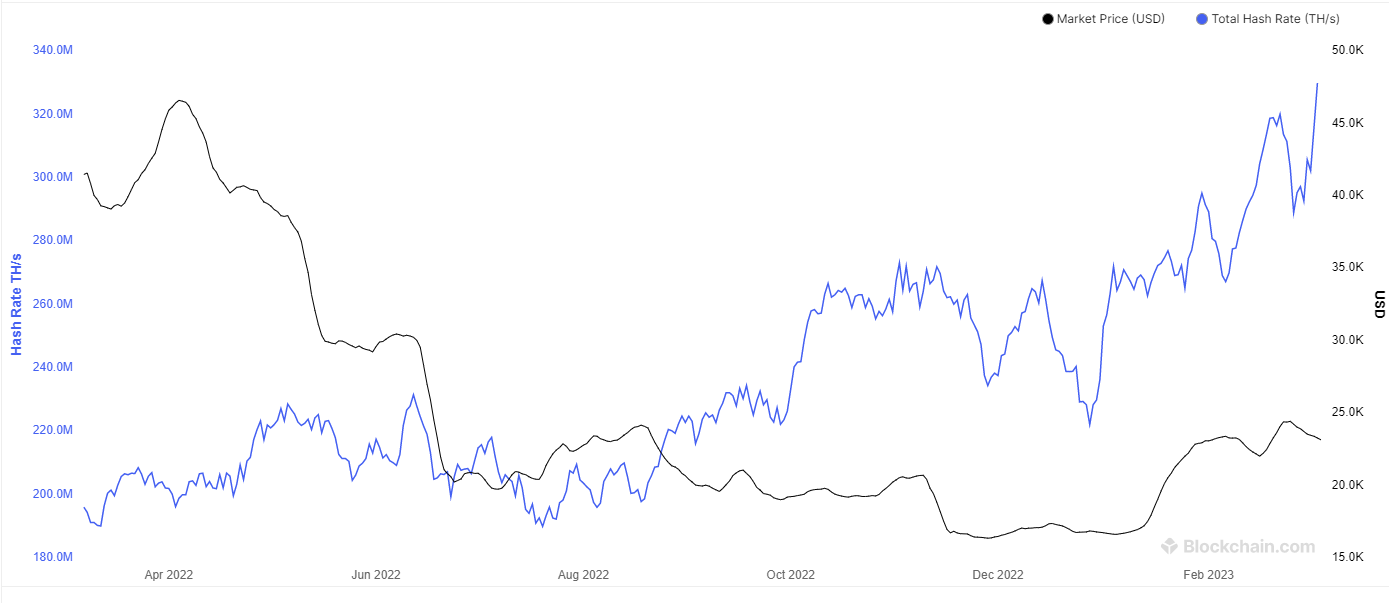The Bitcoin mining difficulty is currently sitting at all-time high values, but miners seem unfazed as the hashrate has only continued to rise recently.
Bitcoin Mining Hashrate Continues Uptrend Despite Difficulty Increase
The “mining hashrate” is an indicator that measures the total amount of computing power that’s currently connected to the Bitcoin network. Its value is measured in terms of terahashes per second (TH/s).
When the value of the metric goes up, it means miners are bringing in more machines online on the network right now. Such a trend shows the current BTC blockchain is attractive to miners.
On the other hand, the indicator’s value declining suggests some miners are disconnecting from the chain at the moment. This kind of trend may imply that miners aren’t finding it that profitable to mine the cryptocurrency currently.
Now, here is a chart that shows the trend in the 7-day average Bitcoin mining hashrate over the last year:

The value of the metric seems to have been sharply going up in recent days | Source: Blockchain.com
As displayed in the above graph, the 7-day average Bitcoin mining hashrate surged and hit a new high a while back, but in the last few days of February, the metric observed a plunge.
This decline was only temporary, however, as, since the start of this month, the indicator has once again shown a strong uptrend and has hit a new all-time high. To understand why the metric may have behaved in this way, the data for the “mining difficulty” is worth looking at.
The difficulty is a built-in concept on the BTC blockchain that decides how hard miners currently find it to mine on the chain. The reason this feature exists is that the network aims to keep what’s called the “block production rate” constant.
This rate is a measure of how fast miners are mining blocks on the network. Whenever the hashrate changes, this rate naturally fluctuates since the computing power available to the miners is also different.
To counter such fluctuations, the Bitcoin blockchain switches the difficulty up or down (depending on whether miners are faster or slower now) just enough that the block production rate goes back to the standard value.
The below chart shows how the BTC mining difficulty has changed recently.

Looks like the value of the metric has spiked recently | Source: Blockchain.com
As you can see above, the Bitcoin mining difficulty hit a new all-time high in the last network adjustment after the hashrate also reached a new high. It’s because of this difficulty increase that the hashrate observed the aforementioned plunge.
When miners find it harder to mine (because of the increased difficulty), they earn lesser revenue. Hence, some small miners who were making low profits begin to see a disconnect when the difficulty spikes like this.
However, it’s interesting how the hashrate decline was only temporary this time around. Miners are still continuing to add more rigs to the network despite the difficulty of continuing to sit at these ATH levels.
This may be a sign that the bigger players in the mining space are likely still very bullish on the future of Bitcoin and find it worth it to expand their mining facilities right now.
BTC Price
At the time of writing, Bitcoin is trading around $22,400, down 4% in the last week.

The asset has moved sideways since the plunge | Source: BTCUSD on TradingView
 bitcoinist.com
bitcoinist.com